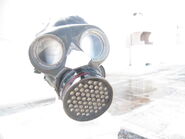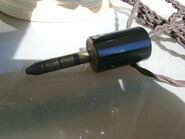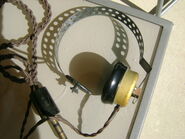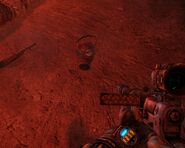Mask Overview
Officially, the Civilian Duty was designed for members of civil air raid precautions services and others who might be called upon to carry out their normal duties in the presence of gas, but who are not likely to be continuously exposed to the highest concentrations.
Whilst often believed to be a wartime design, the Civilian Duty began its conception in the hands of Major. John A. Sadd in the late 1920s. Early prototype Civilian Duty respirators can be seen in a patent filed by Sadd on the 30th October 1928.
As the prospect of war became more and more likely, the CD respirator found itself as the front-line respirator for many civilian based defence organisations such as the ARP, police, ambulance crews, industry and dock workers. The CD would fall out of front-line usage by 1942 as it was around this time that police, firemen and others began being equipped with the GS respirator instead.
Mask
The faceblank of the CD was of stout design compared to the British General Civilian Respirator, due to the conditions in which it was expected to be deployed. It was moulded of much thicker rubber which was the basis for its robustness. The thicker, higher quality rubber allowed the CD to be cleaned by harsher disinfection solutions compared to the GCR - this is noted in many ARP manuals. The facepiece was produced in two sizes: Normal and Small.
Internally, the faceblank features a singular extension of rubber which appears centrally above the eyepiece assemblies which served as structural support for the mask. This same concept is seen in 'L1' faceblanks of the LAG. Externally, the faceblank was moulded with a portion of rubber that served as a mount for a triangular plate that held the flapper valve. This plate was held in place by 3 bolts.
The prospect of using telecommunications equipment whilst under the threat of gas could not be ignored, thus a cylindrical rubber protrusion was moulded with each faceblank. Should a CD respirator require equipping with a microphone and headset, the protrusion could be cut off to allow access for such equipment. The telephonist variants began around 1938.
The head-harness used on the CD respirator was the No.4 Mk III. This harness consisted of 3 strips of elasticated fabric, each 3/4 inch wide, 18 inches long. Each strip was threaded through slots in the back of the rubberised head-pad to form six ends that attached to the buckles on the facepiece.
Vision was provided by two eyepiece assembilies consisting of an outer rim, orange rubber gasket, glass eyepiece disc and an inner rim. The inner rim was designed to be unscrewed by means of a special tool ('Key, securing, eyepiece'). The ability to dissassemble was advantageous for 2 reasons, firstly, any damage pieces could be easily replaced, secondly, it made decontamination easier.
Spectacles could be worn with the Civilian Duty, provided the arms of the spectacles were suficiently thin enough not to interfere with the seal of the mask. The spectacles came with the following information:
This spectacle frame is designed for ordinary use and for use while wearing a respirator. When the respirator is fitted the spectacle sides are adjusted to the correct setting for the wearer's face. Care must be taken to keep the sides at the correct setting otherwise gas may leak in when the respirator is worn. If in any doubt as to the fitting of the spectacles, the matter should be reported to the Medical Officer.
Filter
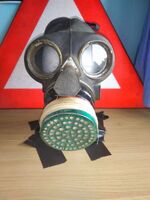
A Civilian Duty with the 'Contex' filter
In the 1930s it was decided that the CD filter should provide 1/10th of the protection offered by GS respirator filters. That is to say, the CD filter had to provide protection for the same amount of time as a GS filter but with the gas concentrations being ten times lower.
Generally, the filter was adhered to the facepiece by either binding with rubber or by a latch-clamp assembly. The filter used in the Civilian Duty was a circular lacquered 'box' type filter. It contained higher quality activated charcoal than the General Civilian models. All pre-war filters had their charcoal made from steam-activated coconut shells. Later in the war, briquetted coal was used, due to a shortage of coconut.
In addition to 90% particulate protection, the following minimum limits were set in place for CD filters in 1933:
|
Gas |
Concentration of gas |
Time (minutes) CD offers protection |
|
|---|---|---|---|
| Phosgene | 1/1000 (4.5mg per cubic metre of air) | 25 | |
| Chloropicrin | 1/5000 (1.5mg per cubic metre of air) | 70 |
C.D. Mark I - This was an early type of filter that was made of a cylindrical waterproofed cardboard filter with two seamed metal ends. This filter contained the normal activated charcoal and particulate filter, but it had an absorbent pad (secured in place with a spring clip) that went inside the masks interior, over the inner end of the filter. This was done because the inner end of the C.D. Mark I had perforations - it was feared that, without a pad, the perforations could harbour bacteria from the wearers breath and disinfection would be difficult without damaging the internals of the filter. After the mask had been cleaned and dried, a new pad was put in.
C.D. Mark II - The Mark II was basically the same as the Mark I, except the filter was made of black lacquered metal. This was probably done because the cardboard of the Mark I was likely fragile.
C.D. Mark III - This is the filter most Civilian Duty masks are found with. It is made of the same lacquered metal as the Mark II but is slightly larger. The Mark III did not require an absorbent pad as the Mark III came with a intake valve that could be removed and disinfected separately, thus ensuring the filters internals were not disturbed during decontamination. It is often seen with a red band painted on, to denote that the filter was for a Civilian Duty. It was important to differentiate between filters intended for CD masks as they contained charcoal with a higher activation than filters intended for the General Civilian Respirator. A green band indicated resin-impregnated wool rather than asbestos-wool. C.D. Mark III filters can be further split into two other variants: 'Mark IIIA' and 'Mark IIIB' - the significance of the A & B designations is unknown.
In May 1940, an additional pre-filter was issued. This addition was known as the 'Contex'. It was constructed of 3/4 inch thick aluminium and adonised green. It contained resin-wool and was constructed due to the fear of Arsenical gases. The standard filter alone was found severely lacking in protection against war gases containing arsenic. It was attached to the regular mask with either black or beige tape.
Gas Drill for Civilian Duty respirator
When it is known that there is no gas in the vicinity, or when there is no likelihood of gas being encountered the respirator is carried in the NORMAL position:
- Respirator in haversack
- Haversack tightly closed and whipcord loops tied in double-bow
- Haversack at left-side of body, as far round the back as is comfortable
When the presence of gas in the vicinity is suspected or when there is a likelihood of gas being encountered the respirator is carried in the ALERT position:
- Respirator in haversack
- Mouth of haverack open fully
- Haversack on left hip, body clear of other equipment so haversack can be swung around to front of body
Immediately gas is encountered or the alarm 'GAS' is received:
- Hold breath
- Grasp bottom of haversack with left hand and swing to front of body, with right hand, remove any headgear and place between knees
- Remove respirator from haversack, making sure to take hold of respirator by the binding that connects the filter to the facepiece
- Insert left thumb under the centre of the head-harness, release grip with right hand to allow respirator to hang by the harness on left thumb, insert right thumb alongside left thumb and slide thumbs apart to stretch harness
- Thrust chin into facepiece and draw harness over the face
- Breathe out
- Adjust respirator as necessary
- Replace headgear
When it is thought that gas may no longer be present:
- Inhale deeply and insert two fingers of right hand between cheek and facepiece
- Gently lift mask with fingers and sniff
- If gas is detected or there is any doubt, put mask back on fully
- Strongly exhale to blow out any gas that may of seeped in during test
When the air is known to be clear of gas:
- Raise headgear with left hand
- Insert two fingers under the chin of the facepiece and lift off with an upward and backward movement over the head
After using the respirator:
- Inside of respirator should be wiped clean
- Treat eyepieces with anti-dimming compound
- If conditions do not permit immediate anti-dimming treatment, it must be done so at the first avaliable opportunity
Politics and Supply of Civilian Duty Respirators
In October 1935 a memorandum sent to the Defence Requirements Committee by the Chemical Defence Research Department suggested that around 400,000 Special Service (Civilian Duty) masks were required at a cost of around £260,000. The War Office was given overall authority on the Special Service/Civilian Duty supply programme. The number of Special Service respirators thought to be required would fluctuate as the ARP services grew. Sometime around 1937, it was suggested that the Department had grossly underestimated the number of Civilian Duty respirators that would be required. A programme for 900,000 Civilian Duty masks was thus put in place. By midsummer of 1938, the overall contract for 900,000 Civilian Duty masks was nearing completion. At some point, the number for Civilian Duty mask procurement was once again upped to 1.3 million masks - on 1st March 1939 Sir J Anderson stated to the House of Commons: Of civilian duty respirators, which are a more complicated contraption, we have obtained delivery of very nearly 1,000,000—to be exact, 940,000—out of a total demand of 1,300,000.
The large amount of rubber and other materials used to complete the Civilian Duty meant that production was strained as the war went on and even services such as the fire guards or medical practitioners were not readily issued them. Indeed, the issue of Civilian Duty masks to certain groups became somewhat a contentious issue;
Firstly, any medical practitioner was able to apply for a civilian duty respirator and a steel helmet from August 1940 onwards, as confirmed by Mr. M MacDonald (then Health Secretary) in October 1940:
I have already been in communication with the Minister of Home Security on this matter and the arrangements under which any medical practitioner may obtain a steel helmet and civilian duty respirator were announced in August. I am sending the hon. Member a copy of that statement.
The scheme for civilian duty respirators for medical practitioners was apparently strained, as confirmed by Mr. Groves on the 5th November 1940. Groves asked Mr. H. Morrison (Home secretary) 'whether he is aware that many doctors who have applied, and paid, for steel helmets and civilian duty respirators under the scheme arranged with the Central Medical War Committee are complaining that they have not received delivery or any intimation when delivery will be made' Mr. Morrison replied:
Orders received by my Department from Secretaries of Local Medical War Committees are met promptly after receipt and I am not aware of any cause for exceptional delay in delivery.
In August 1942, Mr. Glenvil Hall enquired as to why fire guards had not been issued such respirators. Mr. H Morrison replied stating I am afraid that with present shortage of rubber it is not possible to authorise the issue of civilian duty respirators to fire guards. Later, on 28th January 1943, Flight-Lieutenant Challen, noting that the GCR (General Civilian Respirator) which fire guards were issued, were inadequate for this purpose and requested the issue of Civilian Duty masks to fire guards. Mr. H Morrison once again refused to increase Civilian Duty stocks, stating: the provision of very large numbers of additional civilian duty respirators would not be justifiable in present circumstances
The fire guards had 2 main issues with the GCRs they had been issued. Firstly, the GCR design had no apparatus for spectacle wear meaning fire guards couldn't wear glasses, while this was less of a problem for civilians, being able to see clearly was of importance to those fighting fires and mounting rescue operations. Secondly, the mask kept slipping around, making it more difficult for fire guards to do their duty. While little could be done to support fire guards who needed to wear glasses, Mr. H Morrison later stated that in order to alleviate the slip problem, fire guards would be taught how to tie their GCR straps in a particular way, as so to decrease mask slippage.
Certification Mark scheme
In 1936, it was decided by the Government to allow private factories to sell their own respirators. In order to ensure that the respirators on sale were fit for purpose, a Home Office Certification Mark scheme was introduced. A company could apply for a license to apply the Certification Mark to their respirators.
On 8th April 1936, Mr. G Lloyd, the Under-secretary of state for the Home Department, stated to the House of Commons that the Government have devised a scheme, the details of which are about to be published, by which manufacturers who make approved types of respirators and who accept various conditions, including liability to Government inspection, will be licensed to affix a Home Office certification mark to their respirators
Generally speaking, the Home Office Marks were adhered to the Civilian Duty on the filter via a sticker and also a white-ink stamp of the certification mark on the side. J.E. Baxter used red-gold stickers and Siebe-Gorman used gold stickers (later Siebe-Gorman marks were merely ink stamps on the filter). In total 3 different mark schemes were introduced - License No.1 (GCR) License No.2 (Civilian Duty) License No.3 (GSR).
Whilst the Certification mark scheme was believed to be intended for civilians to purchase higher quality masks, O'Brien (1955) states that the target audience was those of industrial concerns.
Parts and manufacturers
|
Part of respirator |
Manufacturer |
Additional comments |
|
|---|---|---|---|
| Facepiece | Avon Rubber, PBC (P.B. Cow & Co.), Siebe-Gorman (S.G & Co.), | Several sources indicate 4.5 million faceblanks produced, it should be noted that these companies were contracted only for the facepiece. | |
| Filter Canister (body) | BW&M, MB | BW&M refers to Barringer, Wallis and Manners a tin manufacturer who were also contracted to make tins for Anti-gas ointment and parts for Mule gas masks.
Companies who were producing private-purchase Civilian Duty respirators (mark scheme) used MB produced canisters. Identity of company 'MB' currently unknown. | |
| Eyepiece screws | WHB, HBS, | Reused in post-war civilian duty mask | |
| Gasket | ? | ||
| Flapper valve | LBR (Leyland Birmingham Rubber) | ||
| Head-harness | W&G (Waring & Gillow) | ||
| Haversack | W&G (Waring & Gillow), Hampton and Sons, Maple | In 1903, W&G acquired Hampton and Sons.
The haversacks intended for mark scheme respirators usually have the name of the company that produced the actual respirator e.g. Siebe Gorman | |
| Asbestos | Cape Asbestos Co (?) | In 1939, it acquired Acre Mill in Hebden Bridge, where it began making gas mask filters unknown if the asbestos from CAC was for both military and civilian or if only for one or the other. | |
| Clamp assembly | Collardo, Longbottom & Co, H.T. & S. | ||
| Filter assembly | Blackburn Mill | According to T.H. O'Brien, the Blackburn Mill (which produced the GCR) was also responsible, at least in part, for the assembly of the CD filters | |
| Final Assembly of respirator | Regional Stores | According to T.H. O'Brien, the final assembly of Civilian Duty masks occurred at regional stores in Middlesex. |
Post War model

Date stamp of post-war example, November 1961
Despite being often considered a wartime design, the Civilian Duty had more longevity than most collectors would give credit for. Siebe-Gorman continued to manufacture this mask long into the 1970s, where it was used in industry and available to purchase by the public.
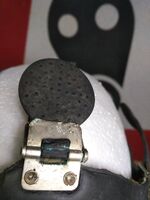
Pull tab and buckle
The Post-war faceblank itself saw little deviation from wartime examples, only the noticeable exception of the removal of the microphone port. The port was obsolete due to the mask being re-purposed as an industrial mask - industry, of course, had no need for protective respirators with microphone assemblies.
The harness assembly was greatly improved. Siebe-Gorman added large, circular textured pull-tabs on each harness strap which made donning and tightening the mask much easier. A metal buckle assembly also added which was much more user-friendly.
Filter
Much like the facepiece, the filter construction was not too dissimilar from the original wartime design. It too was attached to the facepiece with a singular metal clamp. These post-war filters came in at least 3 colours. Red, blue and black. It is unknown if each colour protected against a particular threat. The black filters appear to be the most common, with red and blue being rarer.
Each filter is printed with 'SIEBE-GORMAN' and a date in grey letters. This print usually found at the front or side of the filter.
Collectors note
Some militaria dealers and eBay sellers notice the filter on post-war models is not the same. Through either malice or unknowledge, they may attempt to sell them as some kind of 'rare prototype' or 'Porton Down model'. This is decidedly untrue, these masks are not prototypes (although they are rare).
Gallery
References/Sources
T.H. O'Brien (1955)
Personal Protection Against Gas (1936)
Personal Protection Against Gas (1938)
Protection against gas and air raids pamphlet No.2 'RESPIRATORS' (1941)
Asbestos in World War II Respirator Canisters (1989)






